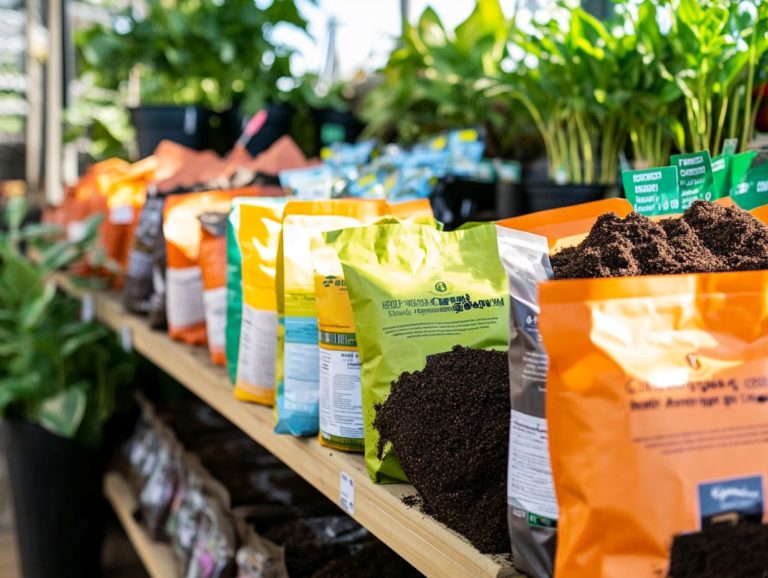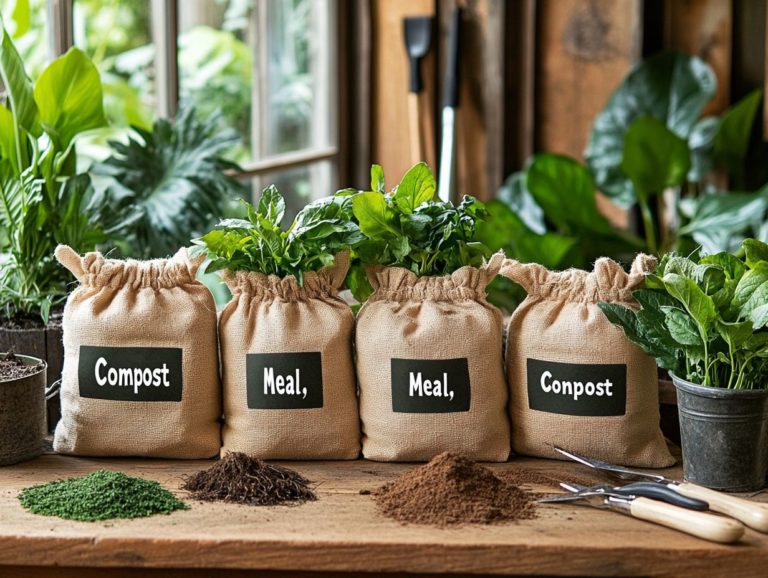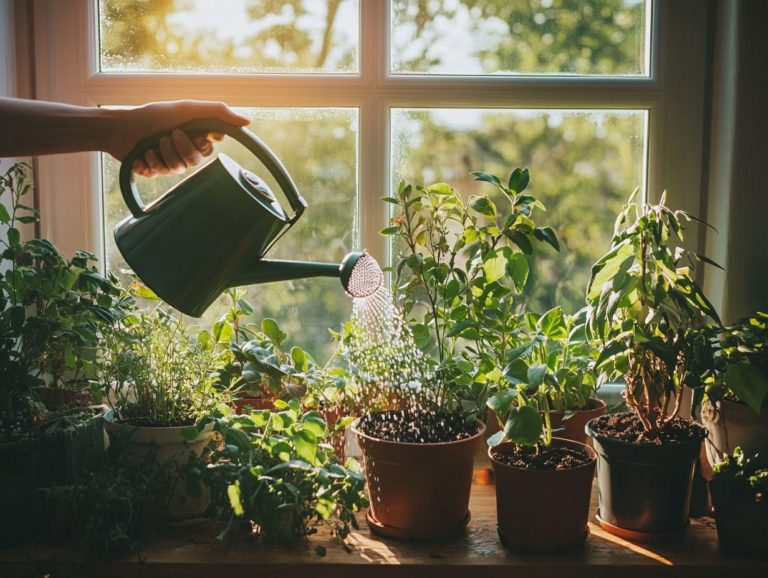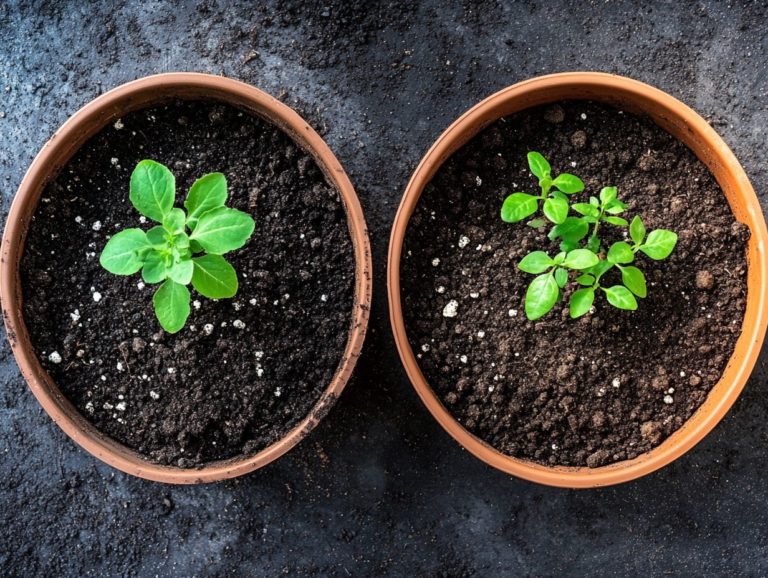Best Soil Types for Indoor Plant Growth
Choosing the right soil is essential for the health and vitality of your indoor plants. With so many options available, it can feel overwhelming to determine where to begin.
This guide explores ten essential soil types, including sandy, loamy, and clay soils, along with popular additives like compost and coconut coir.
You ll find characteristics, optimal plant pairings, and valuable tips for crafting your own potting mix to ensure your indoor garden thrives.
Contents
- Key Takeaways:
- 1. Why Sandy Soil is Perfect for Your Cacti and Succulents
- 2. The Benefits of Loamy Soil
- 3. Improving Clay Soil for Better Plant Health
- 4. Peat Moss
- 5. Vermiculite
- 6. Perlite
- 7. Compost
- 8. Coco Coir
- 9. Potting Mixes
- Choosing the Right Soil for Your Indoor Plants
- What Are the Characteristics of Each Soil Type?
- Which Soil Type Is Best for Which Types of Plants?
- How Can You Create Your Own Potting Mix?
- What Are the Benefits of Using Organic Soil?
- What Are the Common Mistakes When Choosing Soil for Indoor Plants?
- How Often Should You Replace the Soil for Indoor Plants?
- What Are Some Tips for Maintaining Healthy Soil for Indoor Plants?
- What Are Some Alternatives to Traditional Soil for Indoor Plants?
- How Can You Tell If Your Indoor Plants Need New Soil?
- What Are Some Signs of Poor Soil Quality for Indoor Plants?
- Frequently Asked Questions
- What are the best soil types for indoor plant growth?
- Why is potting soil a good choice for indoor plants?
- Can I use regular garden soil for indoor plants?
- What is the role of peat moss in indoor plant growth?
- Do all indoor plants require the same type of soil?
- Are there any alternative soil options for indoor plants?
Key Takeaways:
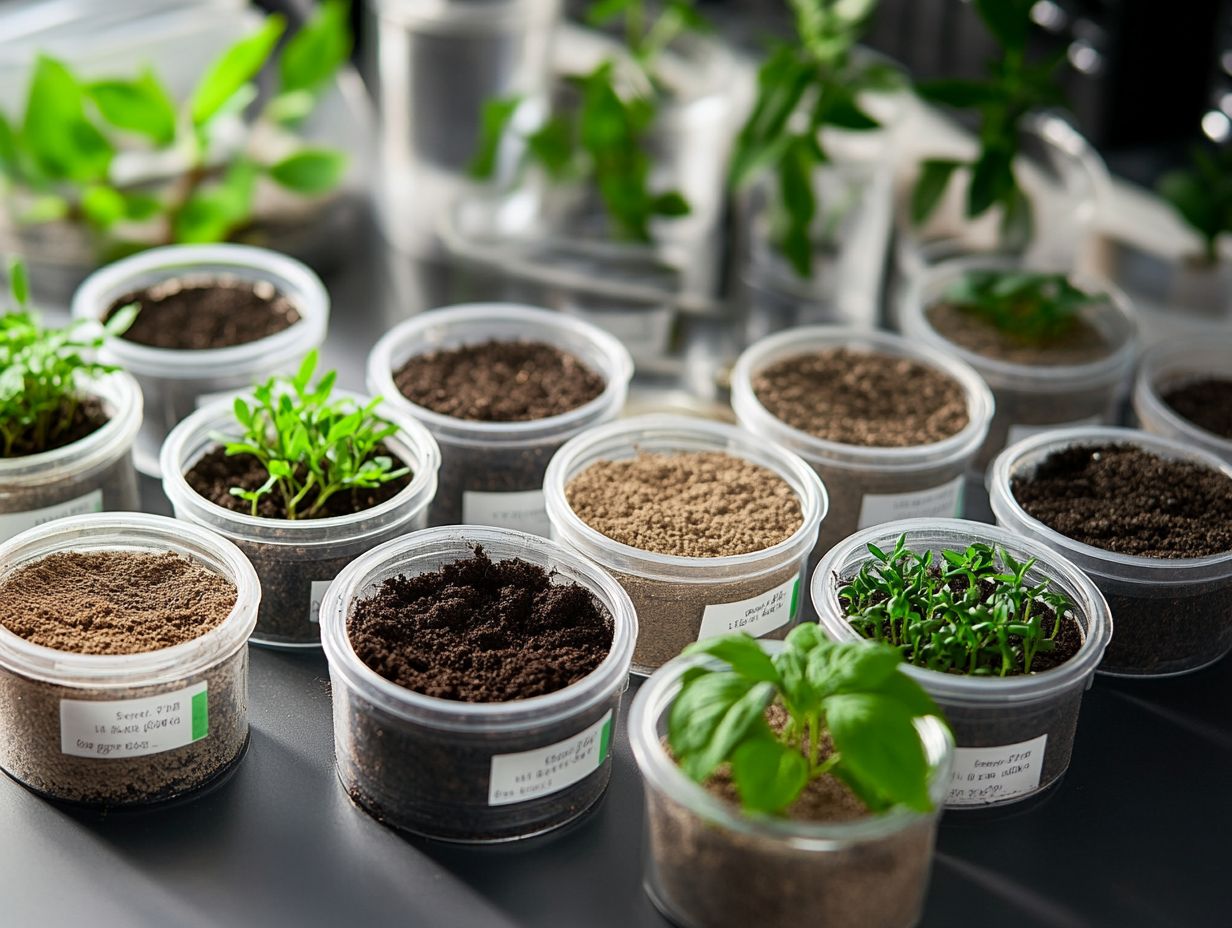
- Sandy soil is best for succulents and cacti due to its excellent drainage. Loamy soil is ideal for a variety of plants with its balanced moisture retention and drainage.
- Avoid clay soil as it can become compacted and hinder plant growth; however, it can improve with organic matter and sand.
- Organic alternatives like peat moss, compost, and coconut coir provide essential nutrients and enhance soil structure, resulting in healthier indoor plants.
1. Why Sandy Soil is Perfect for Your Cacti and Succulents
Sandy soil has a coarse texture and outstanding drainage properties, making it the ideal choice for plants that thrive in well-aerated environments, like cacti and succulents. However, it does present challenges with moisture retention and nutrient availability.
This soil type consists of larger particles that allow rapid water runoff. While this prevents waterlogging, it can also hinder plants from absorbing the moisture they need, especially during dry spells. For drought-resistant plants, sandy soil offers a favorable environment since their root systems can seek moisture deep within the ground.
You can enhance the structure and nutrient content of sandy soil by adding amendments like compost, peat moss, or well-rotted manure. These additions boost moisture retention and improve nutrient availability, paving the way for healthier plant growth.
2. The Benefits of Loamy Soil
Loamy soil is considered the best option for most plants due to its perfect blend of sand, silt, and clay. This harmonious mix ensures excellent drainage, moisture retention, and a rich nutrient profile that fosters healthy root development.
This ideal composition creates a well-aerated environment essential for plants to take in oxygen through their roots. Its ability to hold moisture guarantees that your plants receive the hydration they need without the risk of waterlogging. With a neutral pH level, loamy soil enhances nutrient availability, cultivating a vibrant ecosystem for various plants.
Ultimately, loamy soil acts as a versatile foundation, promoting vigorous growth and sustainability across many gardening endeavors.
3. Improving Clay Soil for Better Plant Health
Clay soil is known for its dense composition and poor drainage, leading to challenges like root rot and inadequate aeration. If you have a garden with clay soil, incorporating effective soil amendments is essential for optimizing plant health.
This type of soil consists of fine particles that clump together, creating a compact and heavy environment. Such conditions obstruct the movement of air and water, resulting in excessive moisture retention. Don’t forget to add amendments like perlite and vermiculite to break up the heavy texture, improve aeration, and promote better drainage.
Integrating organic materials, such as compost, enriches the soil and improves its overall structure. This approach ultimately leads to healthier plants thriving in a well-balanced growing medium.
Get started with the right soil today for a flourishing indoor garden!
4. Peat Moss
Peat moss is a standout soil amendment, renowned for its great moisture retention and its ability to enhance soil structure. This makes it an invaluable addition to organic potting mixes for both indoor and outdoor plants.
By retaining water, it acts as a reservoir, enabling roots to access moisture more efficiently, particularly in drier conditions. This natural material boosts soil aeration, giving roots room to thrive!
When you incorporate peat moss into your potting soil blends, it not only elevates moisture levels but also adds a light, fluffy texture that encourages root expansion. It s essential to think about the environmental impacts of harvesting peat, which raises sustainability concerns.
This awareness may lead you to explore exciting alternatives or mixed formulations that incorporate renewable resources.
5. Vermiculite
Vermiculite is a lightweight soil amendment that you ll appreciate for its great ability to retain moisture while enhancing aeration. This makes it especially beneficial for potting soil blends in your indoor gardening endeavors and propagation methods for a variety of plants.
When you add this mineral to your potting mixes, it doesn t just improve drainage; it also supplies essential nutrients, creating the perfect environment for strong root development. Its unique properties help prevent soil compaction, allowing roots to breathe easier and access vital moisture and nutrients.
In comparison to aeration materials like perlite, which is great for drainage, vermiculite truly shines in moisture retention. This makes it a favorite for those of you aiming to maintain consistent humidity levels.
While coconut coir also boasts impressive water-retaining capabilities, vermiculite s lightweight nature makes it ideal for creating lightweight blends, ultimately fostering a flourishing indoor garden.
6. Perlite
Perlite, a remarkable volcanic glass, acts as an exceptional soil amendment that enhances drainage and aeration. This makes it a favored choice for potting mixes, whether for your indoor jungle or outdoor garden, especially for those tropical plants that crave well-draining soil.
By creating air pockets within the soil structure, perlite not only fosters healthier root development but also reduces the risk of overwatering a common worry for many gardeners. When you incorporate it into your potting mixes, excess water flows freely, minimizing the threat of root rot that can be detrimental even to the most resilient plants.
Its lightweight nature makes it a breeze to handle and transport. For specific plant needs, formulations tailored for succulents and cacti often include varying amounts of perlite to address their unique moisture retention requirements, ensuring optimal growth in a range of environments.
7. Compost
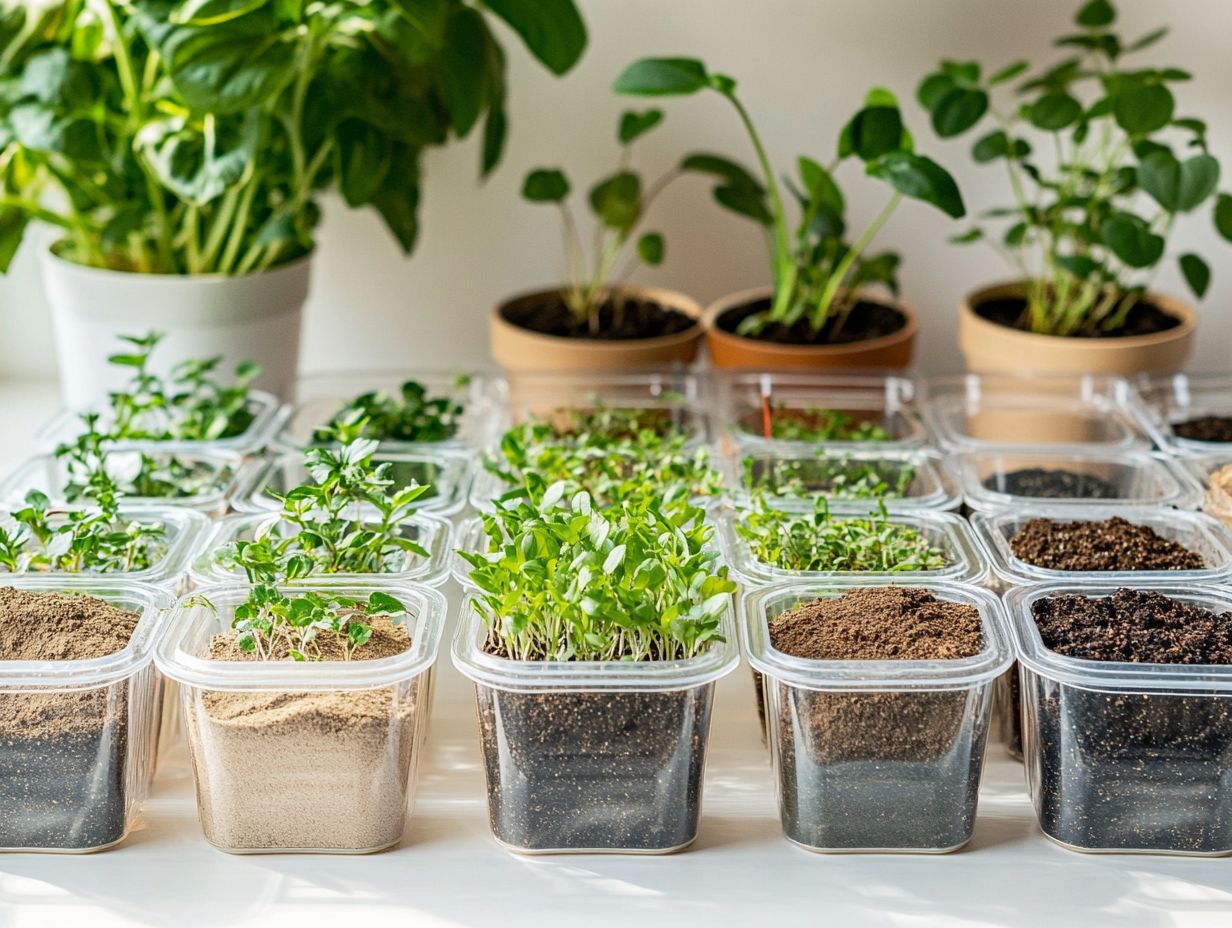
Compost is an essential soil conditioner for you, enriching your potting soil with organic matter and nutrients that promote healthy roots and strong plant growth. It s truly essential for both your indoor plants and outdoor gardening endeavors.
By incorporating compost, you can savor a more balanced nutrient release that gradually nourishes your plants over time, reducing your reliance on synthetic fertilizers. This steady nourishment prevents nutrient spikes that could harm delicate roots.
Plus, compost enhances soil structure, improving aeration and drainage capabilities. Good soil structure is vital for ensuring that water and air circulate efficiently, allowing your plants to thrive.
Healthy soil is alive with beneficial microorganisms that play a critical role in breaking down organic matter, ultimately boosting soil health. This sustainable approach not only fosters a flourishing garden but also makes a positive contribution to the environment.
8. Coco Coir
Coco coir is an eco-friendly alternative to peat moss. You ll love its remarkable moisture retention and ability to allow air flow. It has become a favorite in organic potting mixes for a variety of indoor and outdoor plants, especially those tropical beauties you might adore.
By integrating this sustainable material into your gardening practices, you can significantly lower your environmental footprint. Coco coir is also a natural moisture regulator, ensuring your plants receive consistent hydration without the dreaded risk of waterlogging, which can harm root health. Its fibrous structure promotes excellent drainage, allowing excess water to flow away while keeping essential moisture levels intact.
This perfect balance helps your plants grow strong roots, making them healthier and more vibrant! As more gardeners discover these benefits, the popularity of coco coir continues to soar, firmly establishing it as a staple in modern cultivation.
9. Potting Mixes
Choosing the right potting soil is essential for nurturing healthy potted plants. The right soil mix can enhance growth and ensure the sustainability of your indoor garden.
Potting mixes are specially mixed for the needs of your potted plants. They provide optimal drainage, aeration, and nutrient availability tailored to various indoor plants. For those interested in creating their own, check out these DIY potting mix recipes for indoor plants.
When selecting a soil mix, it’s crucial to consider the specific needs of each plant. Houseplants generally flourish in richer, moisture-retentive soil, while cacti and succulents thrive in a well-draining blend that keeps water retention at bay and encourages airflow. Additionally, understanding soil pH for indoor plants can further enhance their growth.
These mixes often include materials like perlite, sand, or coconut coir to enhance drainage. You should also consider the environmental factors where your plants will reside; for example, high humidity requires different amendment types compared to a dry climate.
Choosing the right soil blend not only fosters healthy growth, but also minimizes common issues like root rot or nutrient deficiencies, ensuring your indoor or outdoor garden remains vibrant and thriving.
Choosing the Right Soil for Your Indoor Plants
Selecting the right soil for your indoor plants is essential for their health and vitality. Each plant has specific soil requirements that directly influence root growth, moisture retention, and overall well-being.
Take tropical plants, for example; they flourish in rich, organic potting mixes that retain moisture while allowing for adequate drainage. This ensures their healthy roots can breathe freely. Orchids, with their unique root systems, thrive in specialized bark-based blends that replicate their natural habitats, providing excellent airflow and quick drying after watering. Additionally, there are top indoor plants that thrive in poor soil for those looking to diversify their collection.
On the flip side, succulents demand gritty, well-draining soil to fend off root rot, reflecting their natural adaptations to arid environments. Soil pH is another critical aspect to consider; it’s a measure of how acidic or alkaline your soil is, which affects how well your plants can absorb nutrients.
Maintaining proper moisture levels is equally vital. Soil that holds too much water can lead to fungal issues, while overly dry conditions can stress your plants. By understanding these factors, you can create an ideal environment tailored to each type of indoor plant, including using the essential soil components for indoor plants.
What Are the Characteristics of Each Soil Type?
Each soil type be it sandy, loamy, or clay possesses unique characteristics that influence drainage, moisture retention, and texture. These factors are crucial in determining which plants will flourish under specific conditions.
Take sandy soils, for example. They excel in drainage, allowing excess water to escape quickly. This trait helps drought-tolerant plants but makes it tough for those that need consistent moisture.
Conversely, clay soils are water retainers, making them ideal for moisture-loving species. However, their compactness can pose difficulties for root growth and oxygen flow.
Loamy soil is often regarded as the gold standard, skillfully balancing sand, silt, and clay. It provides a perfect environment for a diverse array of plants, thanks to its ability to retain nutrients while ensuring proper drainage. Soil pH can dramatically affect nutrient availability; some plants thrive in acidic conditions, while others prefer alkaline soils. Understanding these elements is vital for achieving success in gardening and agriculture.
Which Soil Type Is Best for Which Types of Plants?
Understanding which soil types suit your specific plants is crucial for successful indoor gardening. Different plants have their own demands regarding moisture, drainage, and nutrient availability all essential for promoting healthy growth.
Take the Monstera, for example. It thrives in a well-draining potting mix enriched with organic matter, helping retain moisture while keeping root rot at bay. In contrast, the Fiddle Leaf Fig prefers a slightly heavier mix that offers stability and retains moisture without succumbing to waterlogging.
These carefully chosen soil selections cater to each plant’s unique moisture and nutrient needs. They play a significant role in overall health and growth potential. By recognizing your houseplants‘ distinct requirements, you can create optimal conditions that lead to vibrant foliage and thriving life.
How Can You Create Your Own Potting Mix?
Creating your own potting mix offers you the ultimate opportunity for customization, tailored precisely to the specific needs of your plants. By blending soil ingredients like peat moss, compost, perlite, and coconut coir, you can achieve the perfect balance essential for robust root growth.
This approach helps your plants get the right nutrients. It also provides excellent drainage and aeration. To craft a successful mixture, start with a foundation of:
- 50% peat moss or coco coir for optimal moisture retention
- 30% compost to supply essential nutrients
- 20% perlite or vermiculite to enhance soil aeration and drainage
By understanding the unique requirements of various plants, you can easily adjust these ratios to cater to specific needs, whether they thrive on moisture or prefer to withstand drought. For more detailed guidance, check out this how to test soil quality for indoor plants. This flexibility maximizes growth and resilience, ultimately leading to a flourishing garden or an impressive indoor plant sanctuary.
What Are the Benefits of Using Organic Soil?
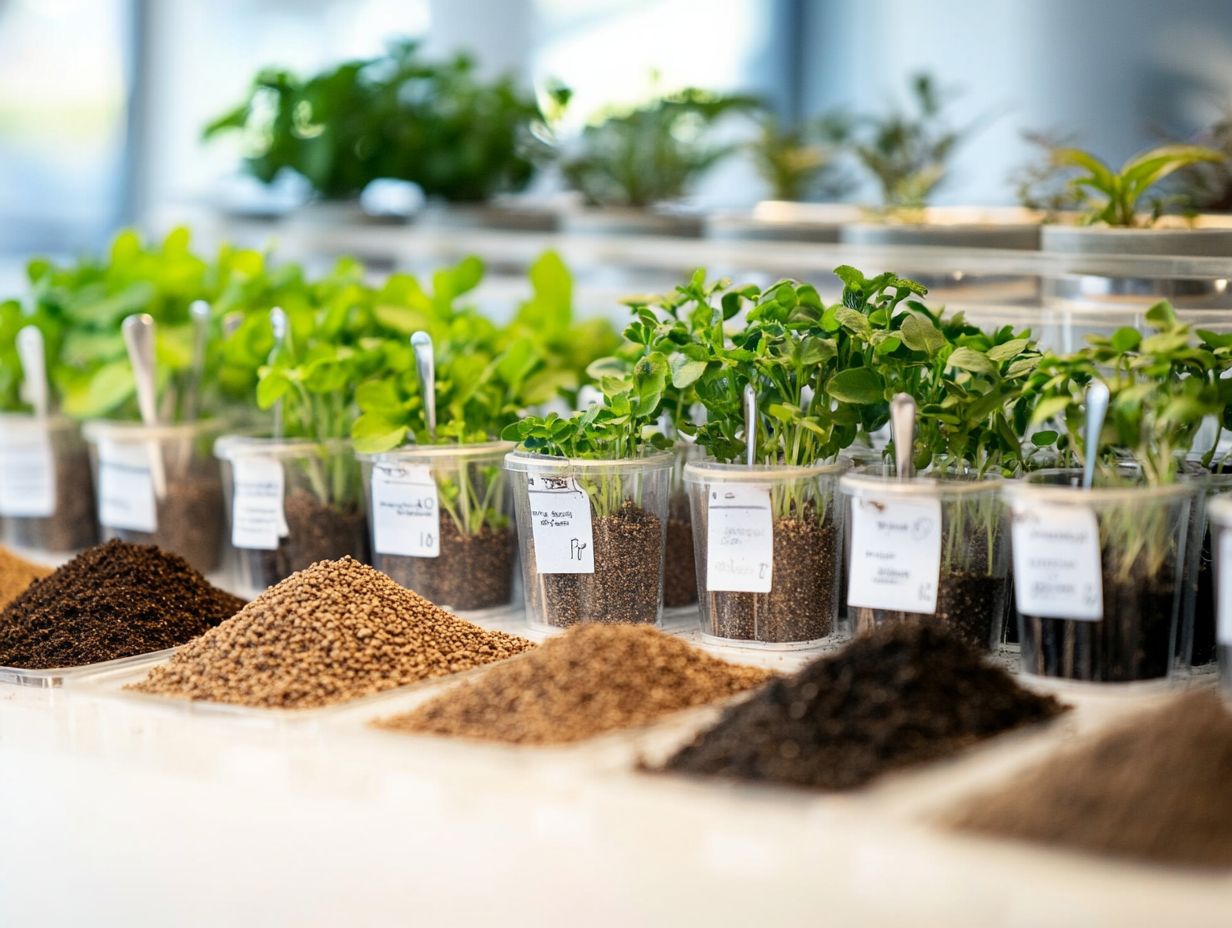
Using organic soil provides you with a plethora of benefits, such as improved nutrient availability, enhanced soil structure, and a healthier environment for your plants. This approach is a game-changer for sustainable gardening!
When you opt for organic soil, you’ll likely witness a remarkable enhancement in your plants’ overall resilience. Unlike synthetic fertilizers that can cause nutrient runoff and deplete the soil, organic amendments like worm castings and compost enrich your soil with beneficial microorganisms. This revitalizes the soil, leading to better water retention and increased organic matter. Over time, your garden’s ecosystem will thrive, resulting in deeper root systems and reduced vulnerability to pests and diseases.
Ultimately, embracing organic methods not only nurtures the environment but also cultivates healthier plants that yield superior produce. Start using organic soil today and watch your garden thrive!
What Are the Common Mistakes When Choosing Soil for Indoor Plants?
Many plant parents make mistakes when choosing soil for their indoor plants. Heavy soil retains too much moisture, leading to root rot and compromising overall plant health.
These oversights can stunt long-term growth by creating an environment that fails to nourish plants properly or support adequate root development. Ignoring essential factors like drainage needs and acidity or alkalinity levels can further worsen issues. For better results, learn how to maintain soil health for indoor plants, leading to less frustration for those eager to cultivate a thriving indoor garden.
To avoid these pitfalls, it’s essential to choose a well-aerated soil mix that promotes proper drainage. It is also important to monitor pH levels to ensure the soil stays within the optimal range required for your specific plants. Additionally, using the best organic fertilizers for indoor plants can greatly enhance their growth and health.
How Often Should You Replace the Soil for Indoor Plants?
Regularly replacing the soil for indoor plants is crucial for maintaining soil health. This practice replenishes essential nutrients, enhances soil structure, and helps prevent issues like root rot and pest infestations.
Several factors come into play, including the types of plants you re nurturing and their growth stages. Fast-growing species may require more frequent soil renewal compared to slower-growing counterparts, as they tend to lose nutrients more quickly.
Young plants in active growth might benefit from annual soil changes, while mature specimens could thrive with less frequent replacements. Keep an eye out for yellowing leaves or stunted growth; these are signs that it’s time for a soil refresh. For optimal results, consider using top soil amendments for healthy indoor plants. Regularly testing nutrient levels and incorporating organic fertilizers can further support a vibrant indoor environment for your plants.
What Are Some Tips for Maintaining Healthy Soil for Indoor Plants?
Maintaining healthy soil for your indoor plants requires constant attention to nutrient availability, moisture levels, and soil texture. This ensures each plant enjoys the optimal environment for growth and development.
Regularly incorporate organic fertilizers that enrich your soil without harsh chemicals. Monitoring moisture is crucial; overwatering or underwatering can lead to root rot or dehydration, which you want to avoid.
Understanding the specific needs of each plant type, such as their preference for acidic or alkaline soil, can enhance their health. For more information, check out what to know about soil for houseplants. Conducting regular soil checks allows you to identify nutrient deficiencies early, and timely amendments can invigorate the soil ecosystem. By nurturing a balanced soil environment, you set the stage for resilient, thriving root systems.
What Are Some Alternatives to Traditional Soil for Indoor Plants?
Exploring alternatives to traditional soil for your indoor plants can unlock innovative growing methods. Consider using coconut coir, hydroponic systems, or other soil substitutes tailored to meet specific plant needs.
These alternatives offer distinct advantages, making them ideal for various plant types. For example, coconut coir excels at retaining moisture while providing excellent aeration, perfect for moisture-loving plants.
Hydroponic systems deliver a nutrient-rich solution directly to the roots, fostering rapid growth especially beneficial for herbs and leafy greens. You can also mix perlite or vermiculite with potting mixes to enhance drainage and aeration, particularly for succulents.
By embracing these alternatives, you can optimize plant health and elevate growth efficiency. Act now to refresh your indoor garden and watch your plants thrive!
How Can You Tell If Your Indoor Plants Need New Soil?
Identifying the signs that your indoor plants need new soil is crucial for maintaining their health. Look out for indicators like stunted growth, poor drainage, and waterlogged soil; these signal underlying issues that need your attention.
Other symptoms to watch for include root rot, which often presents with a foul smell and blackened roots. Pest infestations can also sap your plant’s vitality. To effectively assess soil health, take a moment to examine the texture and moisture levels, and consider conducting a simple pH test a test to check how acidic or basic the soil is. If the soil feels overly compacted or shows signs of discoloration, it might be time for a change.
Replacing the soil is particularly important when these signs linger, even with proper watering and fertilization. This ensures your plants thrive in an optimal environment, ready for robust growth.
What Are Some Signs of Poor Soil Quality for Indoor Plants?
Signs of poor soil quality in your indoor plants can appear in various ways, such as yellowing leaves, drooping stems, and that pesky moisture that could lead to root rot and other health complications.
These indicators often hint at deeper issues with soil moisture levels, suggesting that your soil might be holding onto too much water or drying out too quickly. For instance, yellowing leaves can indicate not just a lack of essential nutrients but also that your roots are struggling in compacted or overly saturated soil. This condition can stunt growth. Drooping stems may reflect an insufficient oxygen supply to the roots something crucial for keeping your plants thriving and full of life!
By keeping an eye on these symptoms, you’ll gain valuable insights into the nutrient availability and overall health of your indoor plants, ensuring a flourishing green environment.
Frequently Asked Questions
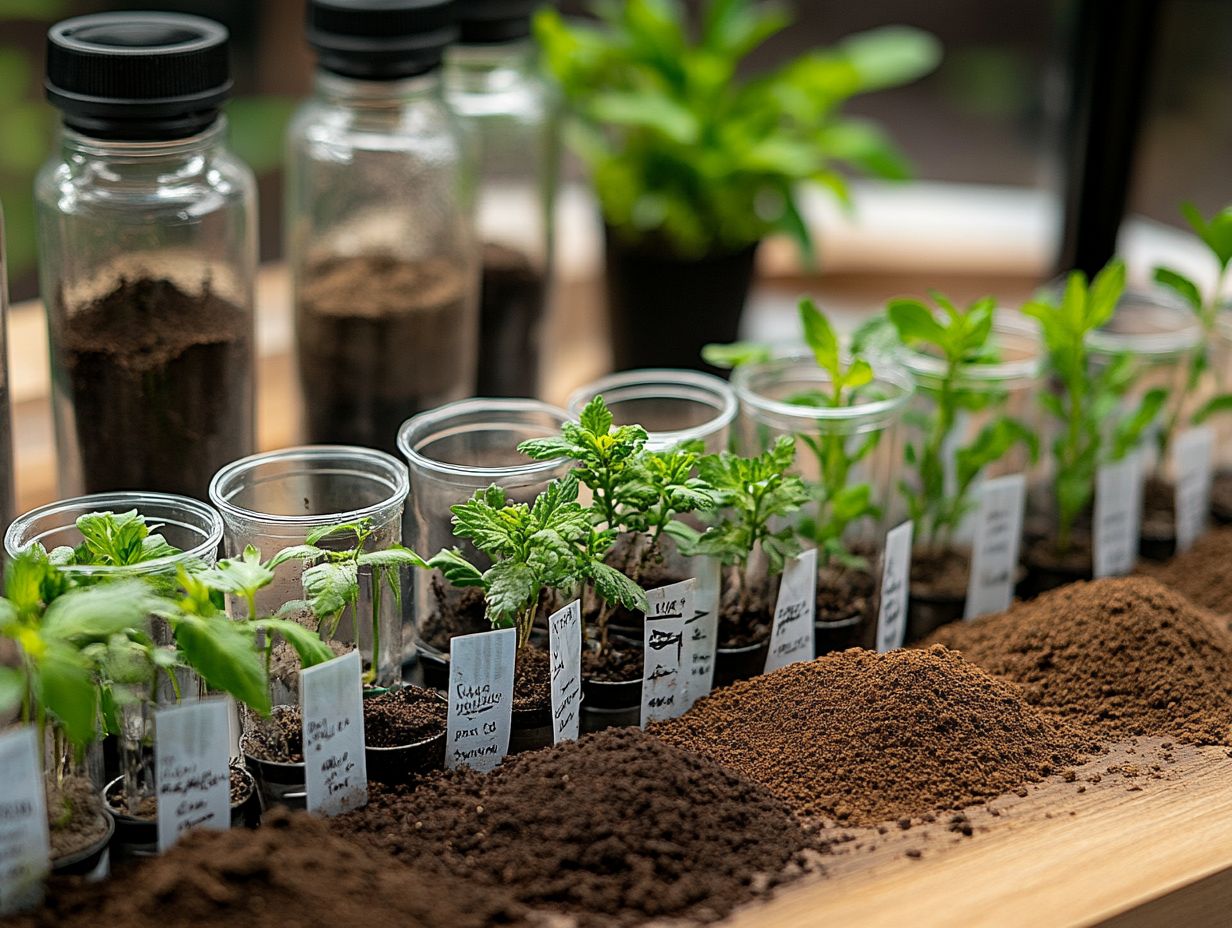
What are the best soil types for indoor plant growth?
The best soil types for indoor plant growth are well-draining and full of nutrients, such as potting soil, peat moss, vermiculite, and perlite.
Why is potting soil a good choice for indoor plants?
Potting soil is a good choice for indoor plants because it is specifically designed for potted plants. It contains a balance of organic matter and minerals to promote healthy growth.
Can I use regular garden soil for indoor plants?
No, regular garden soil is not suitable for indoor plants as it is too heavy and compact. This can lead to poor drainage and root rot. It also contains outdoor pests and diseases that can harm indoor plants.
What is the role of peat moss in indoor plant growth?
Peat moss is an excellent soil amendment for indoor plants. It helps retain moisture, improves drainage, and provides essential nutrients to the plants.
Do all indoor plants require the same type of soil?
No, different types of indoor plants may have varying soil requirements depending on their specific needs. Make sure to check out the soil needs of each plant before potting them.
Are there any alternative soil options for indoor plants?
Yes, besides potting soil, you can also use a mixture of equal parts peat moss, perlite, and vermiculite for indoor plant growth. This combination provides excellent drainage and aeration for the plants.

